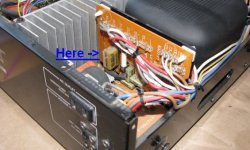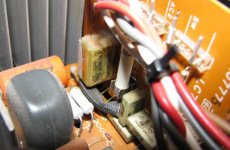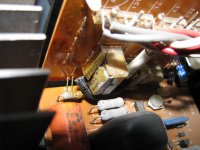zoranaudio said:Hi!
About the capacitor , why is so important where exactly is connected that capacitor of 0.22 microf.?
Expecially for non experienced person!
Mister, if you know to de soldering and soldering than just buy or find some new or used capacitor and be careful with the voltage rating.
If the original is 250 AC than find capaitor same value and voltage rate same as original or even better higher voltage for example 400v or 630 volts, and don't care about the shape of the capacitor, if the new capacitor fits in place there everything is done.
But for un experienced person : Before do anything turn off power and disconnect the main cable from the wall socket!!!
Hi Mooly/Unclejed - I am asking these basic questions because I am just getting into electronics after years of wanting to be able to repair my own stereos. In this case, with a low value cap, I thought I would venture out a little. Reading up on the fundamentals of electronics, and got myself an oscilloscope, but that's for later. So, I really appreciate all the education and advise that I am getting from you guys on diy! This is fascinating!
So, I checked for continuity (w/o plugging into the wall!), but with the power button on. One side of the cap is connecting to neutral, and the other leg has continuity to the other incoming power. So, you're right. Bascially this cap sits across the main supplies, on the primary side (so it must be the noise filter cap as unclejed mentioned). I am not sure if I will ever know the root cause...also, I'll try to post some pics tomorrow. Thanks again.
So, I checked for continuity (w/o plugging into the wall!), but with the power button on. One side of the cap is connecting to neutral, and the other leg has continuity to the other incoming power. So, you're right. Bascially this cap sits across the main supplies, on the primary side (so it must be the noise filter cap as unclejed mentioned). I am not sure if I will ever know the root cause...also, I'll try to post some pics tomorrow. Thanks again.
Across the incoming supply sounds right. Nothing in the amp can have caused it to fail. It's either "just one of those things" or a mains spike has finished it off. Having said that it's worth checking for anything like loose fuseholders etc or loose screws in any mains plugs.
As to a replacement, as Unclejed says it's value isn't critical at all, but it's good practice to get one that fits properly. There is nothing worse than seeing bent legs all over the show
Mains filter caps these days are often what are called "self healing" meaning that a "short" occuring in the cap is actually "repaired" by the offending material being vaporised internally without you being aware anything untoward has occured.
Mains filter caps are normally specified as "Class X" or "Class Y", class X normally being used between live and neutral, where if failure were to occur it would not pose any threat to life anyway.
In the UK with 240Vac ( well 230 now officially but nothing changed only the tolerance ) I would always go for a 275 Vac Class X for anything like this. 240 Vac is 680 volts peak to peak.
) I would always go for a 275 Vac Class X for anything like this. 240 Vac is 680 volts peak to peak.
As to a replacement, as Unclejed says it's value isn't critical at all, but it's good practice to get one that fits properly. There is nothing worse than seeing bent legs all over the show
Mains filter caps these days are often what are called "self healing" meaning that a "short" occuring in the cap is actually "repaired" by the offending material being vaporised internally without you being aware anything untoward has occured.
Mains filter caps are normally specified as "Class X" or "Class Y", class X normally being used between live and neutral, where if failure were to occur it would not pose any threat to life anyway.
In the UK with 240Vac ( well 230 now officially but nothing changed only the tolerance
Again you'll back to my sugge. USE THIS:


The varistor is a surge protection device that is connected directly across the AC input. When a power surge or voltage spike is sensed, the varistor's resistance rapidly decreases, creating an instant shunt path for the over-voltage, thereby saving the sensitive control panel components (hopefully). Because the shunt path creates a short circuit, the varistor and the line fuse are subject to be damaged or weakened in the process.
Than 250Vac cap is enough if the original was same to



The varistor is a surge protection device that is connected directly across the AC input. When a power surge or voltage spike is sensed, the varistor's resistance rapidly decreases, creating an instant shunt path for the over-voltage, thereby saving the sensitive control panel components (hopefully). Because the shunt path creates a short circuit, the varistor and the line fuse are subject to be damaged or weakened in the process.
Than 250Vac cap is enough if the original was same to


Quite an old fashioned fault is that  Take the cap out and clean up the PCB with paper towel and alcohol or WD40 or similar, anything to get any carbon of the board where the cap has gone up. Make sure the board is clean and dry.
Take the cap out and clean up the PCB with paper towel and alcohol or WD40 or similar, anything to get any carbon of the board where the cap has gone up. Make sure the board is clean and dry.
Then test the amp, just to make sure all OK. You can run it without the cap fitted. Back at the start you mention using an UPS etc. How do you power the amp ? I don't think I would use it on anything like this. Just use it direct on your wall supply outlet.
As to the cap, something like this,
http://cpc.farnell.com/CA06027/components-spares/product.us0?sku=vishay-bc-components-2222-338-20224
Then test the amp, just to make sure all OK. You can run it without the cap fitted. Back at the start you mention using an UPS etc. How do you power the amp ? I don't think I would use it on anything like this. Just use it direct on your wall supply outlet.
As to the cap, something like this,
http://cpc.farnell.com/CA06027/components-spares/product.us0?sku=vishay-bc-components-2222-338-20224
Mooly - tell me about the old fashionedness of it!!  Great advice about cleaning up the carbon traces. Glad to know that I can run it w/o this cap. The equipment was plugged into the Belkin power strip with Surge protection, but not a UPS. This power strip was what I used for my computer previously, so it should absorb some of the surges that may be present. But I should be just able to run it off the wall outlet as well. I'll look into the cap you have pointed me to. I'll read up on it a little more. This is the one I found on the 'net which had the same value:
Great advice about cleaning up the carbon traces. Glad to know that I can run it w/o this cap. The equipment was plugged into the Belkin power strip with Surge protection, but not a UPS. This power strip was what I used for my computer previously, so it should absorb some of the surges that may be present. But I should be just able to run it off the wall outlet as well. I'll look into the cap you have pointed me to. I'll read up on it a little more. This is the one I found on the 'net which had the same value:
http://www.goldmine-elec-products.com/prodinfo.asp?number=G14109&variation=
I would like to thank everyone for a great education and all the help. Glad I found DIYAudio!
Patrick
http://www.goldmine-elec-products.com/prodinfo.asp?number=G14109&variation=
I would like to thank everyone for a great education and all the help. Glad I found DIYAudio!
Patrick
It reminds of the mains input caps that were always failing in early TV receivers in the UK -- going back a bit mind -- when I first started out. They were rated at 680 volts DC I think, and of course our mains is 680 volts pk/pk. And those things used to blow themselves apart, no self healing caps then.
Just had a look at the one in your link. I don't really think it's up to it ! It just says 250 volt. Not 250 volt AC Class X or Class Y which is what you want.
I see your online
Just had a look at the one in your link. I don't really think it's up to it ! It just says 250 volt. Not 250 volt AC Class X or Class Y which is what you want.
I see your online
This may help explain it,
http://my.execpc.com/~endlr/line-filter.html
What is your mains voltage over there ? If it's 120 Vac then that's 120*1.414 (Root 2) to get the Peak voltage and times that by 2 to get the peak to peak. So thats 170 volts peak and 340 peak to peak.
So a cap of at least 340 volts DC ( and we would NEVER do this ) would be the minimum required. Add to that line variations and then spikes which can be of very high peak values-- even in the 1 to 4 Kv range for very short durations and you see why the "self healing" Class X or Y type is the one to go for.
If your running the amp on a surge protector anyway then that will have even more comprehensive filtering than just a 0.22mfd across the mains making the one in the amp a bit redundant anyway.
http://my.execpc.com/~endlr/line-filter.html
What is your mains voltage over there ? If it's 120 Vac then that's 120*1.414 (Root 2) to get the Peak voltage and times that by 2 to get the peak to peak. So thats 170 volts peak and 340 peak to peak.
So a cap of at least 340 volts DC ( and we would NEVER do this ) would be the minimum required. Add to that line variations and then spikes which can be of very high peak values-- even in the 1 to 4 Kv range for very short durations and you see why the "self healing" Class X or Y type is the one to go for.
If your running the amp on a surge protector anyway then that will have even more comprehensive filtering than just a 0.22mfd across the mains making the one in the amp a bit redundant anyway.
Thanks for the link on line-filters - lots of good info. With the surge protector power strip, in this case, the noise filtering cap probably is redundant. The line voltage here in the states is 110-120v, so I will need a cap of at least 340vDC? I should stay at the .22uF value though, correct?
It does  1nF =1000 Pf and 1nF is 0.001 mfd.
1nF =1000 Pf and 1nF is 0.001 mfd.
In your amp a 0.1 or 0.15 would be fine as well. Some products even have the caps before the switch so it's "live" all the time. In those cases it's even more important to have the correct one as it could fail at any time unattended.
In your amp a 0.1 or 0.15 would be fine as well. Some products even have the caps before the switch so it's "live" all the time. In those cases it's even more important to have the correct one as it could fail at any time unattended.
those protector power strips work most of the time, but some of them have MOV's rated too high, and some of them have MOV's rated too low. the ones rated too high might not clamp until the line voltage reaches 200Vrms, and the ones rated too low clamp at 130Vrms (and eventually fail because the MOV's are operating at the edge of conduction, overheat and die). ideally the surge protector should clamp at 150Vrms. due to the large capacitance of MOV's, they are not really fast enough to clamp a very short spike of 1500V or more. for this, you need a gas tube device. gas tube protectors are usually small enough to fit next to the MOV's in the power strip, and act a lot faster than the MOV's. i'll look up a link later to explain better,
http://www.bourns.com/PDFs/2036.pdf
compare these to MOV's and you will see that they're much faster. and the faster the risetime of the spike, the faster they work. they're also rated at huge amounts of discharge current. using these along with MOV's is the best solution overall for overvoltage and spike protection. there's a description of how they're used here:
http://www.bourns.com/pdfs/bourns_gdt_white_paper.pdf
here in colorado USA, these are almost a neccesity, since lightning and other static discharges are extremely common.
compare these to MOV's and you will see that they're much faster. and the faster the risetime of the spike, the faster they work. they're also rated at huge amounts of discharge current. using these along with MOV's is the best solution overall for overvoltage and spike protection. there's a description of how they're used here:
http://www.bourns.com/pdfs/bourns_gdt_white_paper.pdf
here in colorado USA, these are almost a neccesity, since lightning and other static discharges are extremely common.
Good info on the MOV and the GTD's. How would you even incorporate the GTD's into the circuit? Add in-line after the MOVs? Also, I forgot to comment about your "curl of smoke" signature - that's a good one! The AC power here in the SF Bay Area seems to be pretty stable, except when California was experiencing brown outs many years back during hot summers. This may be the topic for a different thread, but how are you powering your audio equipment? (power strips, UPSs, Monster's power conditioner??) Thanks again for all the great advice.
Hi Slowpat!
I was busy these days.
I see on the photo Crashed Rifa cap., well it is very strange for exactly that type of Rifa transparent caps which is printed inside.
I saw a lot of the same case crashed caps in 80's power supply's from the PC's.
So I started to hate that kind of caps a long time ago.
Try with other cap and don't keen so much about the value and voltages, in your case the rule of the voltage :"The higher - the better".
So for the U.S. standards the cap I would recommend you don't go lower than 250VAC, and AC is very important to be marked as before explained , but don't use cap which is marked 250VDC or this can be seen like 250 V "and straight line" and the line means that it is 250 volts DC current or voltage.
The varistor can protect from the voltage spikes and You should use for your standard, here I am using varistor rated 275VAC.
Some words about line filters:
I tried and build a line filter, not because I had problems with RF but just like to feel difference in Audio quality.
I tested just with my cd player and the pre-=amp, and power amp. was connect direct on the line.
I noticed big difference in sound but not better , It just made the sound flat and without dynamic!!!, and never used again that line filter.
I was busy these days.
I see on the photo Crashed Rifa cap., well it is very strange for exactly that type of Rifa transparent caps which is printed inside.
I saw a lot of the same case crashed caps in 80's power supply's from the PC's.
So I started to hate that kind of caps a long time ago.
Try with other cap and don't keen so much about the value and voltages, in your case the rule of the voltage :"The higher - the better".
So for the U.S. standards the cap I would recommend you don't go lower than 250VAC, and AC is very important to be marked as before explained , but don't use cap which is marked 250VDC or this can be seen like 250 V "and straight line" and the line means that it is 250 volts DC current or voltage.
The varistor can protect from the voltage spikes and You should use for your standard, here I am using varistor rated 275VAC.
Some words about line filters:
I tried and build a line filter, not because I had problems with RF but just like to feel difference in Audio quality.
I tested just with my cd player and the pre-=amp, and power amp. was connect direct on the line.
I noticed big difference in sound but not better , It just made the sound flat and without dynamic!!!, and never used again that line filter.
- Status
- This old topic is closed. If you want to reopen this topic, contact a moderator using the "Report Post" button.
- Home
- Amplifiers
- Solid State
- Yamaha M50 amp went tilt???


